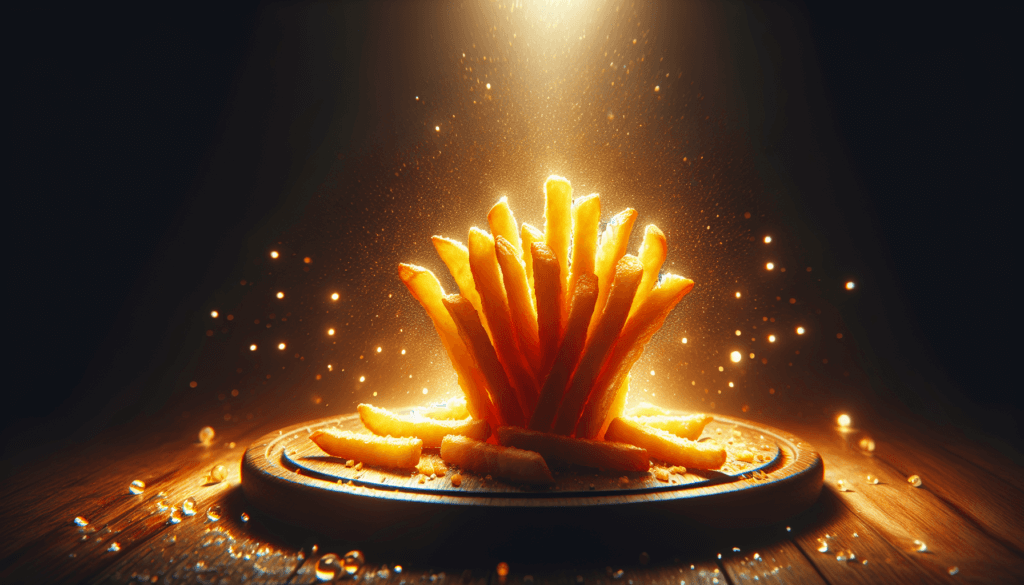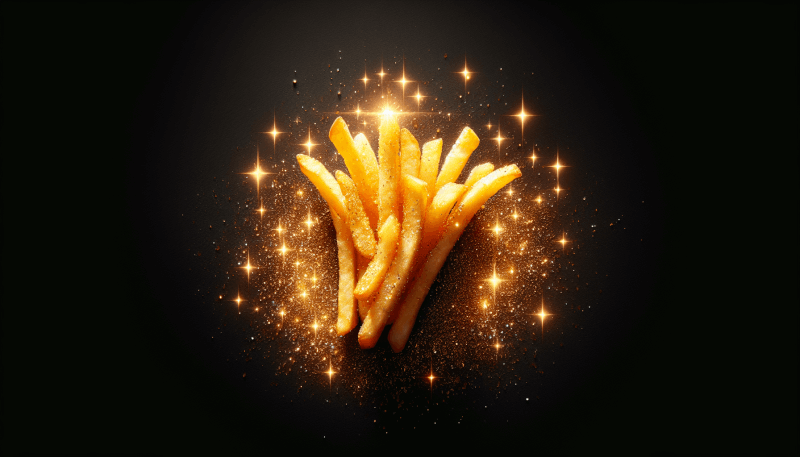If you’ve ever wondered how to achieve that elusive crispy exterior on your homemade french fries, you’re not alone. Many of us have tried various techniques, such as double frying or soaking in water, but the results often fall short. But fear not, because there is a secret to creating perfectly crispy fries that will have you coming back for seconds. In this article, we will uncover the key to achieving the golden, crunchy exterior that is characteristic of the best french fries. Get ready to elevate your fry game and impress your friends and family with your homemade rendition of this classic side dish.

Choosing the Right Potato
Understanding Potato Varieties
When it comes to making homemade French fries, the first step is to choose the right potato. There are various potato varieties available, but not all of them are suitable for making crispy fries. Understanding the different potato varieties can help you make the best choice.
Russet potatoes are often considered the ideal choice for French fries. They have a high starch content and a low moisture content, making them perfect for achieving that desired crispiness. Other suitable varieties include Yukon Gold and Kennebec potatoes, which also have a good balance of starch and moisture.
Selecting the Best Potato Type for French Fries
When selecting potatoes for making French fries, look for ones that are firm and avoid any that have sprouted or have soft spots. The size of the potato is also important – choose potatoes that are medium to large in size for the best results. Smaller potatoes may not yield the desired texture and may cook unevenly.
Preparing the Potatoes
Peeling and Cutting the Potatoes
Once you’ve chosen the right potato variety, the next step is to prepare them for frying. Start by peeling the potatoes to remove the skin. Some people prefer to leave the skin on for added texture and flavor, but for classic French fries, it’s best to peel them.
After peeling, cut the potatoes into evenly-sized sticks or wedges. This is important for ensuring that the fries cook evenly and achieve a uniform golden color. Aim for a thickness of about 1/4 to 1/2 inch for the best results.
Soaking the Potatoes
Soaking the potatoes before frying is a crucial step that many people overlook. It helps to remove excess starch from the surface of the potatoes, resulting in crispier fries. Soaking also allows the potatoes to cook evenly and prevents them from sticking together.
To soak the potatoes, place them in a large bowl of cold water and let them sit for at least 30 minutes, or up to 2 hours. This will give the potatoes enough time to release the starch and absorb some water, making them crispy on the outside and fluffy on the inside.
Drying the Potatoes
After soaking the potatoes, it’s important to dry them thoroughly before frying. Excess moisture on the surface of the potatoes can cause the oil to splatter and may result in soggy fries. Use a clean kitchen towel or paper towels to pat the potatoes dry.
Make sure to remove as much moisture as possible, as dry potatoes will fry more evenly and develop a better crisp. Take your time with this step and ensure that the potatoes are completely dry before moving on to the next stage.

Choosing the Right Oil
Understanding Smoke Point
When it comes to frying, the choice of oil is crucial. Different oils have different smoke points, which is the temperature at which they start to break down and produce smoke. It’s important to choose an oil with a high smoke point to ensure that your French fries cook properly without turning greasy or developing off-flavors.
Some oils with high smoke points that are suitable for frying French fries include vegetable oil, canola oil, and peanut oil. These oils are able to withstand the high temperatures needed to achieve crispy fries without burning or smoking excessively.
Selecting the Best Oil for Frying
While oils like vegetable oil, canola oil, and peanut oil are good choices for frying, you can also experiment with other oils to add different flavors to your fries. For example, using avocado oil or coconut oil can give your fries a unique taste.
When selecting the oil, consider both the smoke point and flavor you desire. Some oils may have lower smoke points but can still be used for frying at lower temperatures. It’s important to balance the smoke point and flavor to achieve the best results.
Preheating the Oil
Why Preheating is Important
Preheating the oil is a crucial step in the frying process. It ensures that the potatoes cook evenly and develop a crispy exterior. When you add the potatoes to cold oil, the fries absorb more oil, resulting in greasy and soggy fries.
By preheating the oil to the recommended temperature, you create a hot environment that quickly seals the exterior of the potatoes, preventing excessive oil absorption. This leads to fries that are crispy on the outside and tender on the inside.
Recommended Temperature for Frying
The recommended temperature for frying French fries is typically around 350-375°F (175-190°C). This temperature range allows the fries to cook through without burning or becoming overly greasy. Investing in a reliable cooking thermometer can help you accurately monitor the oil temperature and achieve consistent results.

Double Frying Technique
Why Double Frying is Effective
One of the secrets to achieving perfectly crispy homemade French fries is the double frying technique. Double frying involves cooking the potatoes in oil twice – once at a lower temperature to par-cook them, and then at a higher temperature to create crispiness.
The first fry at a lower temperature, usually around 325°F (160°C), allows the potatoes to cook through without developing too much color. This step ensures that the inside of the fries is cooked and tender. The second fry at a higher temperature, around 375°F (190°C), creates a golden crust and the desired level of crispiness.
First Fry: Par-Cooking the Potatoes
During the first fry, which is also known as par-cooking, the potatoes should be cooked until they are tender but not yet golden brown. This process typically takes about 5-7 minutes, depending on the thickness of the fries. Once par-cooked, remove the potatoes from the oil and let them rest while you heat the oil to a higher temperature for the second fry.
Second Fry: Creating Crispiness
After par-cooking, raise the oil temperature to around 375°F (190°C) and return the partially cooked fries to the hot oil. Fry them until they turn golden brown and develop a crispy exterior, which usually takes about 2-3 minutes. Keep a close eye on the fries to prevent them from burning.
Seasoning the French Fries
Basic Salt and Pepper Seasoning
While plain salt and pepper can go a long way in enhancing the flavor of your French fries, it’s important to season them while they’re still hot. Sprinkle salt and pepper over the fries immediately after they come out of the oil. The heat of the fries will help the seasoning adhere to the surface, resulting in a more flavorful bite.
Use a fine salt, such as kosher salt or sea salt, for an even distribution of seasoning. If you prefer a more prominent pepper flavor, use freshly ground black pepper. Adjust the amount of salt and pepper to suit your taste preferences.
Experimenting with Seasoning Variations
Once you’ve mastered the basic salt and pepper seasoning, feel free to experiment with different flavor variations. You can add a pinch of paprika or garlic powder for a subtle smokiness or sprinkle some grated Parmesan cheese for a savory twist.
Herbs like rosemary or thyme can also be added for an aromatic flavor, and chili powder or cayenne pepper can bring a nice kick of heat. Get creative and try different combinations to find your favorite seasoning for the perfect batch of homemade French fries.

Using the Right Cooking Equipment
Choosing the Right Pot or Pan
When it comes to frying French fries, choosing the right pot or pan is essential for even cooking and maintaining consistent heat. A heavy-bottomed pot or deep skillet is ideal, as it helps to distribute heat more evenly and prevents the oil temperature from dropping too much when the fries are added.
Make sure that the pot or pan is large enough to accommodate the amount of fries you want to cook without overcrowding. Overcrowding the pot can cause the temperature of the oil to drop too much, resulting in greasy and soggy fries.
Optimizing Deep Fryers
If you have a deep fryer, you can easily achieve consistent results when making French fries. Deep fryers have built-in temperature control, which ensures that the oil remains at the desired temperature throughout the cooking process.
When using a deep fryer, follow the manufacturer’s instructions for preheating the oil and cooking times. Adjust the settings according to the type and thickness of the fries you’re making. Remember to observe safety precautions when using a deep fryer, such as carefully lowering the food into the oil and avoiding overcrowding the fryer basket.
Avoiding Common Mistakes
Overcrowding the Fryer
One common mistake when making French fries is overcrowding the fryer or pot. Adding too many potatoes at once lowers the temperature of the oil too much, resulting in undercooked and greasy fries. It’s important to maintain the recommended oil temperature and cook the fries in small batches for the best results.
By frying the potatoes in small batches, you ensure that each fry has enough space to cook evenly without compromising the temperature of the oil. This will lead to crispy and evenly cooked French fries.
Using Inadequate Oil
Another common mistake is using inadequate amounts of oil for frying. The potatoes need to be fully submerged in the oil to ensure even cooking and crispiness. If there isn’t enough oil, the potatoes may not cook evenly or develop a golden crust.
To determine how much oil to use, consider the amount of potatoes you’re frying and the size of the pot or skillet. The oil should come up about 2-3 inches from the bottom of the pot to provide enough depth for frying. Remember to adjust the amount of oil based on the size of your cooking vessel and the quantity of fries you’re making.
Skipping the Soaking Step
Skipping the soaking step is a common mistake that can lead to less-than-perfect French fries. Soaking the potatoes helps to remove excess starch, resulting in crispier fries. It also helps to prevent the fries from sticking together during frying.
Take the time to soak the potatoes as recommended before proceeding with the recipe. It may seem like an extra step, but it makes a significant difference in achieving crispy, restaurant-worthy French fries.

Ensuring Even Cooking
Stirring the Fries
To ensure even cooking, it’s important to stir the fries occasionally while they’re cooking. This helps to prevent them from sticking together and ensures that all sides are evenly exposed to the hot oil.
Use a slotted spoon or tongs to gently stir the fries every few minutes while they’re frying. This simple step can help to achieve a consistent golden color and crispiness.
Maintaining Consistent Heat
Maintaining consistent heat is crucial for achieving perfectly crispy homemade French fries. Fluctuations in temperature can lead to uneven cooking and greasy fries. To maintain a consistent temperature, use a cooking thermometer to monitor the oil and adjust the heat as necessary.
If you notice that the oil temperature drops significantly after adding the fries, increase the heat slightly to bring it back up to the recommended range. The key is to strike a balance between frying the potatoes at a high enough temperature to achieve crispiness, and at the same time, preventing the oil from smoking or burning.
Serving and Enjoying
Drain and Pat Dry the Fries
Once the fries have reached the desired level of crispiness, carefully remove them from the oil using a slotted spoon or tongs. Allow the excess oil to drain off by placing the fries on a wire rack or paper towels. This helps to remove any excess grease and ensures that your homemade French fries are not overly greasy.
Before serving, pat the fries dry with a clean kitchen towel or paper towels to remove any remaining oil. This will help to keep them crisp for longer and prevent any sogginess.
Serving Suggestions
Homemade French fries are incredibly versatile and can be enjoyed on their own or as a side dish. Serve them alongside burgers, sandwiches, or hotdogs for a classic American meal. They also pair well with dipping sauces like ketchup, mayo, or aioli. For added flavor, sprinkle some grated Parmesan cheese or chopped fresh herbs like parsley or rosemary on top.
Remember to serve the fries immediately after cooking to enjoy them at their crispy best. French fries tend to lose their crispness quickly, so it’s best to serve and enjoy them right away.
Enjoying the Crispy Homemade French Fries
Making crispy homemade French fries requires attention to detail and a few essential techniques, but the results are definitely worth it. By selecting the right potato variety, preparing the potatoes properly, choosing the right oil, and using the double frying technique, you can achieve perfectly crispy fries that rival those from your favorite restaurant.
Don’t be afraid to experiment with different seasonings and oils to add your own personal touch to your homemade French fries. With practice and a little creativity, you can master the art of making crispy, delicious fries at home. So gather your ingredients, follow the steps outlined in this article, and get ready to enjoy the satisfying crunch of homemade French fries!


